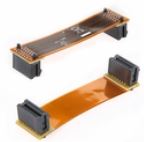SLI
Some motherboards allow SLI and or Crossfire (also called Crossfirex). SLI is by NVIDIA and Crossfire is by AMD. It allows you to use multiple video cards for a single output. This increases the performance. Usually gamers or and high performance users use this feature.
There is different configurations of SLI
-
2-way SLI - capable of using two video cards
-
3-way SLI - capable of using three video cards
-
4-way SLI - capable of using four video cards
NOTE: Check your motherboard to see if your system is compatible with SLI and if it is, see if it is 2-way, 3-way or 4-way
Not all motherboards work with SLI and Crossfire. Also some motherboards may work with SLI but not Crossfire and vice versa. SLI and Crossfire adds expense to building a system because you have to buy two or more video cards depending on the setup you desire. Also there specifications are different for SLI than Crossfire.
Requirements of SLI
-
You have to use the same video cards with the exact same processor for all video cards in the SLI configuration such as two, three or four GeForce 770 video cards. You can't use a GeForce 670 and a GeForce 770 together. The two video cards can be different brands but the processor has to be the same.
-
A power supply with enough connectors and enough power to power the additional video cards.
-
Available Expansion Slots. Some motherboards only allow you to use specific slots even though you have more available.
-
CPU - Your CPU has to be SLI compatible. Some SLI will not work with 28-lane CPUs. Click here for information
-
Operating system that works with SLI.
-
You have to use an SLI bridge to connect the two video cards together with (they come with the motherboard. If it doesn't have one or you need more, you will need to buy one from a computer store such as NewEgg or TigerDirect)
 |
Issues with SLI
-
Not all programs work with SLI so your video quality may be less with those programs
-
Micro Stuttering - using SLI with AFR, the subjective framerate can often be lower than the framerate reported by benchmarking applications, and may even be poorer than the framerate of its single-GPU equivalent
